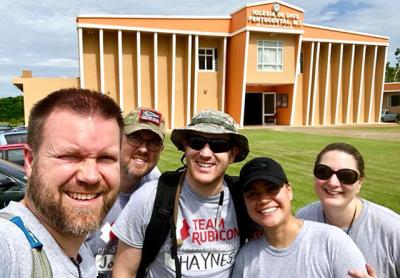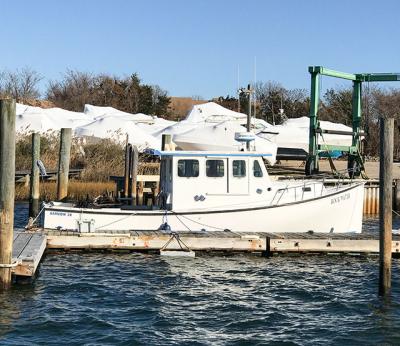Helping Hands for the Forgotten in Puerto Rico
Helping Hands for the Forgotten in Puerto Rico

East Hampton residents are familiar with how the community rallies when someone here is in need, but this fall, thanks to a growing network, efforts to help people in Texas and in Puerto Rico hit by two devastating hurricanes have gotten a boost thanks to some of our neighbors.
East End Cares, an informal networking group formed to help residents of western Long Island after Hurricane Sandy, is once again a nexus. At the height of the refugee crisis in Europe two years ago, East End Cares sent a group of volunteers to Greece and now several of them are once again stepping up to lend a hand.
Earlier this fall Maureen Rutkowski, a Montauk resident, went to Texas to join Team Rubicon, a veterans’ group doing relief work, after East End Cares began fund-raising for the group. And both Denise Schoen, an attorney and a volunteer critical care emergency medical technician in Sag Harbor, who volunteered in Greece, and her husband, Jon Schoen, have made work trips with Team Rubicon to Texas and Puerto Rico.
Over eight days in Puerto Rico last month, Doug Kuntz, a photojournalist and veteran aid worker, worked with a team organized by Alison Thompson of Third Wave Volunteers and took food, water, water filters, and solar lights to residents in remote locations that had gone without since the hurricane. Five years ago, working in the Rockaways after Hurricane Sandy, he had met Ms. Thompson, who was also helping out. The two also did aid work together in Haiti after the 2010 earthquake there, and on the shores of Lesvos in Greece, helping Iraqi, Syrian, and Afghan refugees arriving by sea.
Traveling from San Juan toward Aguadilla and south toward Mayaguez, their team drove more than 600 miles, circumnavigating an island that is only about 100 miles long and a fraction of that wide, and trekking into its interior to encounter areas cut off by mudslides, cities and villages with no water, and decimated areas where no one was helping the residents.
The island’s electrical grid, as has been widely reported, was in bad shape, Mr. Kuntz said. And, while strides had been made to assure access to water, he said shortly after his return, “What do they say, 70 percent of the island has water now? They might, but it’s not drinkable.”
Driving to the end of a dirt road in a little coastal town with the village mayor, he said, they encountered four men with rifles. They were shooting iguanas to eat. “It’s a really impoverished place,” said Mr. Kuntz, and the conditions, post-hurricane, only made things harder. “It’s a mess down there,” said Mr. Kuntz of the island’s southeast coast, where the hurricane made landfall.
It was a month or so after the hurricane when Mr. Kuntz was there, but heading up into the mountains accompanied by police using Humvees they encountered “people who hadn’t seen a soul” come to help since the hurricane, he said. “Every place we went to, we were the only people” there to help that residents had seen, he said. “They kept asking, ‘Are you FEMA?’ ” said Mr. Kuntz. While the hard-hit residents assumed that the United States Federal Emergency Management Agency would arrive to assist, it was, again, the private volunteer groups on the ground meeting immediate needs. “We never saw FEMA once,” Mr. Kuntz said.
“It’s the same thing that I’ve seen all over the world. It’s independent people that just care, that get things done.”
Team Rubicon, whose motto is to “get shit done,” was founded by retired military personnel after the Haiti earthquake, putting the skills of veterans and first responders to use in quickly deploying emergency response teams.
In a stadium in the town of Arecibo, west of San Juan, sharing the space with FEMA and other groups. Ms. Schoen’s Team Rubicon group set up a clinic, where they saw up to 100 patients a day. They slept on cots and ate military M.R.E.s, or meals ready to eat. “We saw lots of people who did not have medication for their diabetes, for their hypertension,” she said this week. The team had provided enough medicine to get patients back on track, and Ms. Schoen spent part of the time organizing their pharmacy.
There was no running water for part of the time, and, without air-conditioning, no relief from the heat.
During her time on the island, Ms. Schoen said, half of Team Rubicon’s Puerto Rico volunteers provided medical care while the other half was assigned as a tree-sawing team, cutting and clearing fallen logs or precariously leaning trees damaged by the hurricane and posing a danger. “The island is just decimated; it looks like a war took place there,” Ms. Schoen said in a phone interview this week.
“The storm damage and continued suffering here is astonishing after more than two full months of recovery time,” she wrote in a Nov. 16 report from Puerto Rico.
Three Team Rubicon “strike teams” took to the field daily, she said, negotiating washed-out bridges and other challenges to reach remote mountain locations where, the volunteers had been told, people needed medical care. Each medical team had two paramedics, a doctor and nurse, and two interpreters.
“Every time we were out in the field, we would get a tip,” about villages in need. When the medical team got on site, she said, residents would come out of their houses to greet them. “It was amazing how communities stuck together and were able to guide us to people who really, really needed our help,” Ms. Schoen said.
Her group met a pastor who urged them to help his parishioners. In three hours after church, the medical professionals saw 43 patients, several of whom were diagnosed with serious medical conditions.
For all of the aid workers, the experience was not only challenging but transformative. “Everybody there was wonderful; they all worked together as a team,” said Ms. Schoen, who made it home to Sag Harbor just in time to share Thanksgiving with her family. As in Greece, she said, “in a week’s time I made friends for a lifetime. Those people are so outstanding.”
“They truly pull together in times of crisis to care for and look out for one another,” and to get things done “for the people who need it the most,” she wrote in a post on Facebook upon her return. “They made me appreciate my life in a more determined way.”
Ms. Schoen said she and her family have long been involved in helping others, from raising guide dogs to hosting a child through the Fresh Air Fund, to her work as an ambulance volunteer. Ever since her move back to the East End, after leaving a large law firm in New York City, she said, she has felt a “compelling urge to give back, because I feel really fortunate for what I have.”
Two years ago, when she saw Mr. Kuntz’s photos from Greece “I knew I could be helpful over there.”
“I was scared,” she said, but nonetheless she joined the East End Cares team. Since then, she’s been back to Greece twice — once to work with a medical group, the Health Point Foundation, at the Moria refugee camp on Lesvos, and once to work at two other camps and to help with a benefit concert organized by Marcus Lovett, a Broadway actor who got involved to support East End Cares. She plans another trip soon.
Refugees are still flowing into Greece, and, with borders to other European countries closed, conditions for them there have only worsened. Lisa Campbell, a Virginia resident whose organization, Do Your Part, partnered with East End Cares for the 2015 volunteer trip, has been in Greece just about ever since, establishing and running the Oinofyta refugee camp. In a blow to both its residents and volunteers, it was just closed by the Greek Ministry of Migration.
But, after a brief Thanksgiving visit with her family back in the States, Ms. Campbell has returned to Greece, ready to set up a new camp and continue to help refugees at a community center. Ms. Schoen, who had been set, before the Oinofyta camp’s closing date was moved up from the end of this year, to go again to Greece this week to help Ms. Campbell dismantle it, will be there soon to help.
“I want it to be part of my life forever, when these situations arise,” she said of her relief work. “I want to be connected to an organization where I can pick up and go.”
But not, perhaps, as quickly as she had to for her Puerto Rico trip. Because of regulations regarding Puerto Rico licensure for critical care emergency medical technicians versus paramedics, a higher level of certification, she was not sure she could be deployed to the island for Team Rubicon. But on the evening of Nov. 13 she was notified she was scheduled to go, and had to leave at 6 a.m. the next day. “I hadn’t even packed; I was in a full-on panic,” Ms. Schoen said. Nonetheless, she is ready to do it again.





